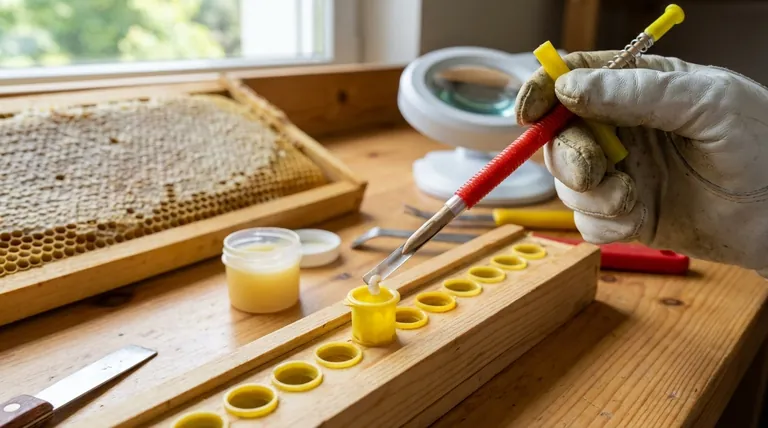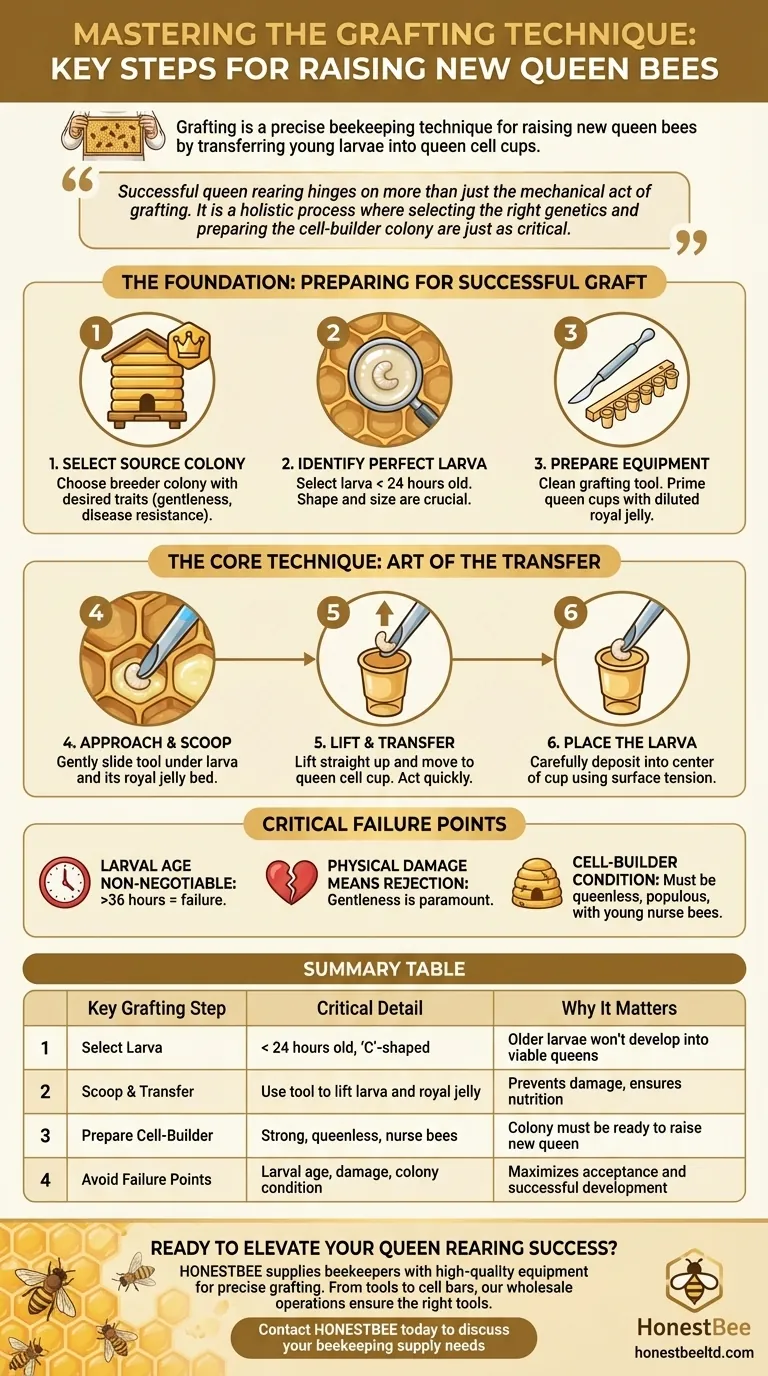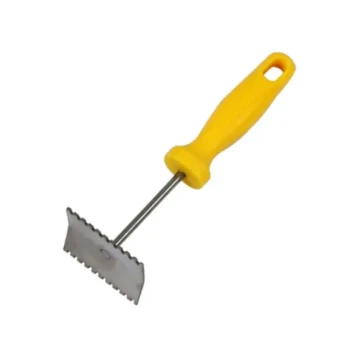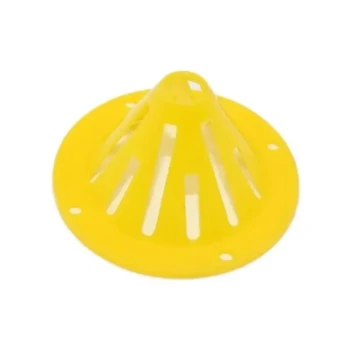Grafting is a precise beekeeping technique for raising new queen bees. The core process involves selecting a honey bee larva less than 24 hours old, carefully lifting it from its wax cell using a specialized tool, and transferring it into a pre-made queen cell cup. This grafted cell is then placed in a strong, queenless "cell-builder" colony, which will raise the larva into a new queen.
Successful queen rearing hinges on more than just the mechanical act of grafting. It is a holistic process where selecting the right genetics and preparing the cell-builder colony are just as critical as the delicate transfer of the larva itself.

The Foundation: Preparing for a Successful Graft
The work you do before ever touching a larva has the greatest impact on your success rate. This preparatory phase sets the stage for healthy, well-accepted queen cells.
Step 1: Select the Source Colony
The first step is choosing the right "breeder queen" colony. This hive should exhibit the genetic traits you wish to propagate, such as gentleness, disease resistance, or high honey production. The colony must be strong and healthy.
Step 2: Identify the Perfect Larva
Success depends entirely on the age of the larva. You must select one that is less than 24 hours old.
These larvae are extremely small, shaped like the letter "C," and appear to be floating in a milky pool of royal jelly. Older larvae will not be properly fed by the nurse bees to develop into queens.
Step 3: Prepare Your Equipment
Ensure your grafting tool is perfectly clean. Some beekeepers moisten the tip with water or royal jelly to prevent the larva from sticking.
Your cell bars, which hold the plastic or wax queen cups, should be ready. Some methods involve "priming" these cups with a tiny drop of diluted royal jelly to create a welcoming environment for the transferred larva.
The Core Technique: The Art of the Transfer
This is the delicate, hands-on part of the process. It requires a steady hand, good eyesight, and patience. The entire transfer should be done quickly to prevent the larva from drying out.
Step 4: Approach and Scoop the Larva
Position the grafting tool behind the outer curve of the "C"-shaped larva.
Gently slide the flexible tip of the tool along the cell wall and underneath both the larva and its bed of royal jelly. You are not picking the larva up; you are scooping up the entire package.
Step 5: Lift and Transfer
Lift the tool straight up and out of the worker cell. The larva and its royal jelly should now be resting on the tool's tip.
Move the tool to your prepared queen cell cup.
Step 6: Place the Larva
Carefully deposit the larva into the center of the queen cup. This is often done with a gentle rolling motion of the tool or by drawing the tool's tip across the base of the cup.
The surface tension of the royal jelly (or priming liquid) will help the larva slide off the tool and into its new home.
Understanding the Critical Failure Points
Grafting has a steep learning curve because several factors can lead to failure. Understanding them is key to troubleshooting and improving your acceptance rates.
Larval Age is Non-Negotiable
Grafting a larva older than about 36 hours is a guaranteed failure. The dietary switch that determines whether a larva becomes a worker or a queen happens in the first three days, and you must intervene at the very beginning of this window.
Physical Damage Means Rejection
Any damage to the larva during the scooping or placing process will cause the nurse bees in the cell-builder colony to reject and discard it. Gentleness is paramount.
The Cell-Builder Colony's Condition
A perfect graft will fail if the receiving colony is not in the right state. The cell-builder must be queenless, populous, and overflowing with young nurse bees that have an instinctual drive to build queen cells and feed royal jelly.
Making the Right Choice for Your Apiary
Focus your efforts based on your primary goal for queen rearing.
- If your primary focus is maximizing acceptance rate: Concentrate on selecting the youngest possible larvae and ensuring your cell-builder colony is exceptionally strong and hopelessly queenless.
- If your primary focus is improving your physical technique: Practice on drone larvae first, as they are larger and more expendable, to master the scooping and placing motion without risking valuable queen prospects.
- If your primary focus is genetic improvement: Be ruthless in your selection of the breeder queen's colony, prioritizing the specific traits you want to see in your apiary's future generations.
Mastering these steps transforms you from a beekeeper into a queen breeder, giving you ultimate control over the health and genetics of your apiary.
Summary Table:
| Key Grafting Step | Critical Detail | Why It Matters |
|---|---|---|
| Select Larva | Less than 24 hours old, 'C'-shaped | Older larvae won't develop into viable queens |
| Scoop & Transfer | Use a grafting tool to lift larva and royal jelly | Prevents damage and ensures proper nutrition |
| Prepare Cell-Builder | Must be strong, queenless, full of nurse bees | Colony must be ready to accept and raise the new queen |
| Avoid Failure Points | Larval age, physical damage, colony condition | Maximizes acceptance rate and successful queen development |
Ready to Elevate Your Queen Rearing Success?
Mastering the grafting technique is essential for commercial apiaries and distributors focused on genetic improvement and hive health. HONESTBEE supplies beekeepers with the high-quality, reliable equipment needed for precise grafting and successful queen production. From specialized grafting tools to durable cell bars and cups, our wholesale-focused operations ensure you have the right tools for the job.
Contact HONESTBEE today to discuss your beekeeping supply needs and learn how our products can help you build a stronger, more productive apiary.
Visual Guide

Related Products
- Retractable Chinese Queen Rearing Grafting Tools Equipment
- Plastic Chinese Queen Grafting Tool for Bee Queen Rearing
- No Grafting Queen Rearing Kit: System for Royal Jelly Production and Queen Rearing
- Stainless Steel Scraper for Metal Queen Bee Excluders
- HONESTBEE Bee Frame Grooving Machine | Precision Slotting for Bee Frame Making
People Also Ask
- What characteristics make larvae suitable for grafting? Select the Perfect Larva for Queen Rearing
- What is the process of grafting larvae? Master the Art of Queen Rearing for Your Apiary
- What are the steps involved in the grafting process? Master Queen Rearing for Your Apiary
- How should the frame of larvae be prepared for grafting? A Guide to Maximizing Larval Survival
- What should be done to ensure grafted larvae are well-fed? Master the Principle of Abundance for Queen Rearing



















